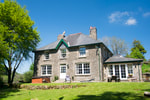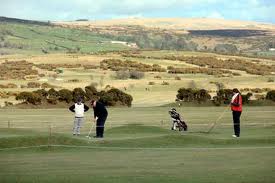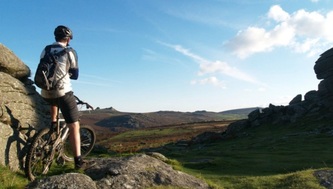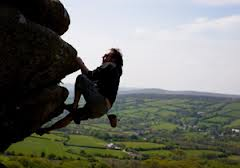info@wydemeet-dartmoor.com
|
+44 (0)1364 631390
|
We are perfectly positioned to explore the whole of Dartmoor, as we are right in the middle, with footpaths meeting almost outside our garden gate, going north, south, east and west; whether you are on foot, horseback or cycling.
Hill Walking
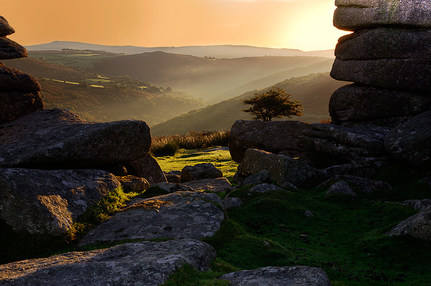
Combestone Tor, down the road from Wydemeet
Dartmoor is the largest and wildest area of open country in southern England.
Its varied landscape of open moorland, steep sided river valleys and ancient deciduous woodland provides great opportunities for walking. The granite tors for which the National Park is famous offer challenging routes and exciting bouldering.
The oldest leisure pursuit on the moor is hill walking. William Crossing's definitive Guide to Dartmoor was published in 1909, and in 1938 a plaque and letterbox in his memory were placed at Duck's Pool on the southern moor. Parts of the Abbots Way, Two Moors Way and the Templer Way are on Dartmoor. Your dog will always be grateful to you for a trip to Wydemeet!
You can also go rock climbing on the granite tors and outcrops, some of the well-known venues being Haytor, Hound Tor and The Dewerstone; or Combestone Tor, just down the road from Wydemeet.
Its varied landscape of open moorland, steep sided river valleys and ancient deciduous woodland provides great opportunities for walking. The granite tors for which the National Park is famous offer challenging routes and exciting bouldering.
The oldest leisure pursuit on the moor is hill walking. William Crossing's definitive Guide to Dartmoor was published in 1909, and in 1938 a plaque and letterbox in his memory were placed at Duck's Pool on the southern moor. Parts of the Abbots Way, Two Moors Way and the Templer Way are on Dartmoor. Your dog will always be grateful to you for a trip to Wydemeet!
You can also go rock climbing on the granite tors and outcrops, some of the well-known venues being Haytor, Hound Tor and The Dewerstone; or Combestone Tor, just down the road from Wydemeet.
Fishing
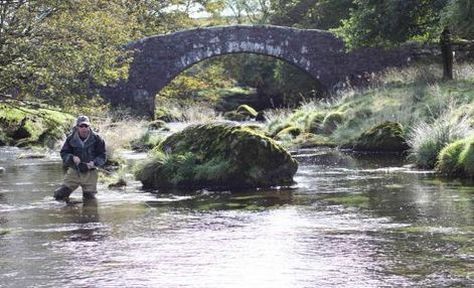
Fishing for trout & salmon on the Swincombe, just outside our garden gate!
Wydemeet was originally built as a fishing lodge by the May family from Totnes who came up to fish from it, every summer. This is because the house is situated almost on the confluence of the Rivers Swincombe and West Dart. They kept their rods in what is now the 'teen outhouse' and one of them, a lady called 'John' could be seen always dressed in brown, with flies pinned all over her clothes.
Dartmoor's rivers are noted for their fishing of wild brown trout, sea trout and salmon. Much of the river fishing on Dartmoor is privately owned but around us you can fish on wonderful stretches of the East and West Dart Rivers on the purchase of a relatively inexpensive Duchy of Cornwall permit (contact 01822 890205).
Reservoir fishing is also available within the National park. Information about reservoirs and permits is available from the South West Lakes Trust on 01837 871565. www.swlakestrust.org.uk
Tavistock Trout Fishery has five lakes and tuition is available 01822 615441
Dartmoor's rivers are noted for their fishing of wild brown trout, sea trout and salmon. Much of the river fishing on Dartmoor is privately owned but around us you can fish on wonderful stretches of the East and West Dart Rivers on the purchase of a relatively inexpensive Duchy of Cornwall permit (contact 01822 890205).
Reservoir fishing is also available within the National park. Information about reservoirs and permits is available from the South West Lakes Trust on 01837 871565. www.swlakestrust.org.uk
Tavistock Trout Fishery has five lakes and tuition is available 01822 615441
Bird Watching
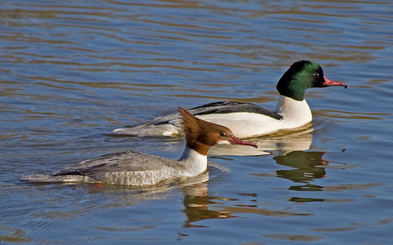
Goosanders in Hexworthy
Bird Watching in Dartmoor is special in many ways, and it is a very popular destination for birders. Ornithologically, it has many features that make it different from other upland areas of Britain. Birding in Dartmoor may lack the sheer number of species found in the grander mountainous uplands of the North, but it does have a certain mix of lowland heath species and upland species that is unique in the British Isles.
Dartmoor is a truly unique natural area. A National Park since 1951, it covers 368 square miles of upland moor and bog, lowland heath, deciduous valley woodland , coniferous plantations, reservoirs, rivers and farmland. In these varied habitats 254 species and sub-species of birds have been recorded. Because some of these species are at the very Northernmost edge of their world range, and others, such as Dunlin, Golden Plover or Red Grouse are at their Southernmost edge, Dartmoor is the only place where they can be found in close proximity.
There is a pair of Goosanders which can often be seen around Hexworthy, and every Spring we are visited by house martins which swoop around under our eaves and in and out of our barn. Buzzards are one of our most common species and can often be seen close up, sitting on top of posts and walls! Wydemeet is a landing spot for birds flying across the moor, as it offers the only trees for some distance, with open moorland all around. We have an expert guide on hand, should you wish to be shown what the area has to offer of particular interest.
Dartmoor is a truly unique natural area. A National Park since 1951, it covers 368 square miles of upland moor and bog, lowland heath, deciduous valley woodland , coniferous plantations, reservoirs, rivers and farmland. In these varied habitats 254 species and sub-species of birds have been recorded. Because some of these species are at the very Northernmost edge of their world range, and others, such as Dunlin, Golden Plover or Red Grouse are at their Southernmost edge, Dartmoor is the only place where they can be found in close proximity.
There is a pair of Goosanders which can often be seen around Hexworthy, and every Spring we are visited by house martins which swoop around under our eaves and in and out of our barn. Buzzards are one of our most common species and can often be seen close up, sitting on top of posts and walls! Wydemeet is a landing spot for birds flying across the moor, as it offers the only trees for some distance, with open moorland all around. We have an expert guide on hand, should you wish to be shown what the area has to offer of particular interest.
Kayaking
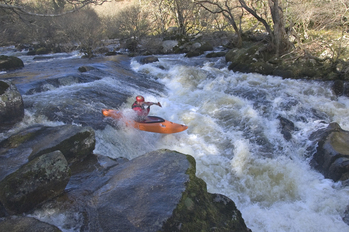
Kayaking on the River Dart
Whitewater kayaking and canoeing are popular on the rivers due to the high rainfall and their high quality, though for environmental reasons access is restricted to the winter months.
The River Dart is the most prominent meeting place, the section known as the Loop , just down the road from us, being particularly popular. Other white water rivers are the Erme, Tavy, Plym and Meavy.
The River Dart is the most prominent meeting place, the section known as the Loop , just down the road from us, being particularly popular. Other white water rivers are the Erme, Tavy, Plym and Meavy.
Horse Riding, Cycling and Golf
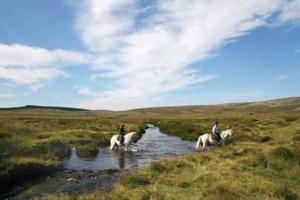
Horse riding on Dartmoor
We are keen riders and can give you as much information as you like about riding around the moor.
We can also direct you towards the best trekking stables nearby, supply you with maps and suggested routes, and will happily prepare a packed lunch for you.
Babeny Farm, for instance, run by our old friend Dee Dee Wilkinson, is one of the most respected riding establishments in the area, and has been operating as a trekking centre for more than 30 years.
It’s located near Poundsgate and is a Duchy Dartmoor Farm. Dee Dee represents the fourth generation of the Wilkinson family who have farm there.
Absolute beginners as well as more experienced riders are welcome to take up the reins and experience Dartmoor’s stunning landscape from the back of one of Babeny’s wonderful horses.
Groups are split according to ability with the option of 1 hour (£35) 2 hour (£50) or half day pub rides (£65).
If you’d like more information visit www.babenystables.co.uk or call Dee Dee on 01364 63129
You could even go on a day's trek around the area used for the recent film, 'War House'. It is very beautiful and very remote!
There are two spectacular golf courses, at Tavistock and Yelverton, that make use of the moor, with the ponies, sheep and cattle actually meandering around them!
We can also direct you towards the best trekking stables nearby, supply you with maps and suggested routes, and will happily prepare a packed lunch for you.
Babeny Farm, for instance, run by our old friend Dee Dee Wilkinson, is one of the most respected riding establishments in the area, and has been operating as a trekking centre for more than 30 years.
It’s located near Poundsgate and is a Duchy Dartmoor Farm. Dee Dee represents the fourth generation of the Wilkinson family who have farm there.
Absolute beginners as well as more experienced riders are welcome to take up the reins and experience Dartmoor’s stunning landscape from the back of one of Babeny’s wonderful horses.
Groups are split according to ability with the option of 1 hour (£35) 2 hour (£50) or half day pub rides (£65).
If you’d like more information visit www.babenystables.co.uk or call Dee Dee on 01364 63129
You could even go on a day's trek around the area used for the recent film, 'War House'. It is very beautiful and very remote!
There are two spectacular golf courses, at Tavistock and Yelverton, that make use of the moor, with the ponies, sheep and cattle actually meandering around them!
Activities Unique to Dartmoor
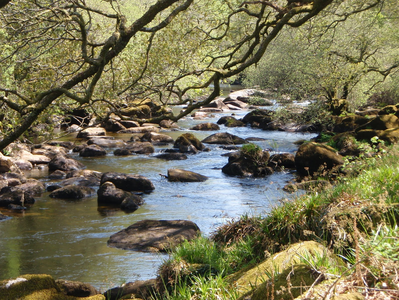
Until the early 19th century Dartmoor was not considered to be a place worth visiting: in the 1540s John Leland wrote in his Itinerary that "Dartmore is muche a wilde Morish and forest Ground", and even by 1789 Richard Gough's opinion was that it is a "dreary mountainous tract". At the turn of the 19th century John Swete was one of the first people to visit Dartmoor for pleasure and his journals and watercolour paintings now provide a valuable historical resource.
Letterboxing originated on Dartmoor in the 19th century and has become increasingly popular in recent decades. Watertight containers, or 'letterboxes', are hidden throughout the moor, each containing a visitor's book and a rubber stamp. Visitors take an impression of the letterbox's rubber stamp as proof of finding the box and record their visit by stamping their own personal stamp in the letterbox's logbook.
A recent related development is geocaching. Geocache clues make use of GPS coordinates, whereas letterboxing clues tend to consist of grid references and compass bearings.
Letterboxing originated on Dartmoor in the 19th century and has become increasingly popular in recent decades. Watertight containers, or 'letterboxes', are hidden throughout the moor, each containing a visitor's book and a rubber stamp. Visitors take an impression of the letterbox's rubber stamp as proof of finding the box and record their visit by stamping their own personal stamp in the letterbox's logbook.
A recent related development is geocaching. Geocache clues make use of GPS coordinates, whereas letterboxing clues tend to consist of grid references and compass bearings.
Do contact us for further information!
Wydemeet, Central Dartmoor, Hexworthy, Yelverton, Devon, PL20 6SF
info@wydemeet-dartmoor.com |
+44 (0)1364 631390 |
Site powered by Weebly. Managed by JustHost
